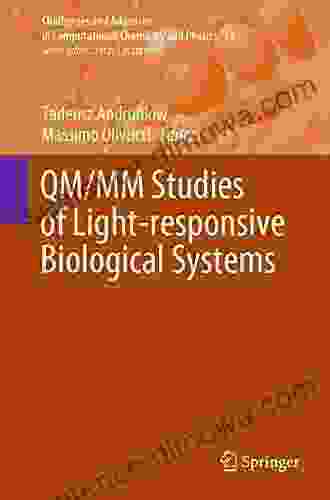Qm Mm Studies Of Light Responsive Biological Systems Challenges And Advances In

This book provides a comprehensive overview of the latest research on light-responsive biological systems, with a focus on the challenges and advances in the field.
5 out of 5
| Language | : | English |
| File size | : | 61163 KB |
| Text-to-Speech | : | Enabled |
| Enhanced typesetting | : | Enabled |
| Print length | : | 670 pages |
| Screen Reader | : | Supported |
Light-responsive biological systems are systems that are able to respond to light in a variety of ways. These systems include plants, animals, and bacteria. Plants use light to photosynthesize, animals use light to see, and bacteria use light to regulate their metabolism.
The study of light-responsive biological systems is a rapidly growing field. This is due to the increasing importance of light in our lives. Light is used in a variety of applications, including medicine, energy, and communication.
The challenges in the study of light-responsive biological systems include:
- The complexity of light-responsive systems
- The difficulty of measuring light-responsive systems
- The lack of understanding of the mechanisms of light-responsive systems
The advances in the study of light-responsive biological systems include:
- The development of new technologies for measuring light-responsive systems
- The discovery of new mechanisms of light-responsive systems
- The development of new applications for light-responsive systems
This book is a valuable resource for researchers in the field of light-responsive biological systems. It provides a comprehensive overview of the latest research on the subject, and it identifies the challenges and advances in the field.
Table of Contents
- Light-Responsive Biological Systems
- Challenges in the Study of Light-Responsive Biological Systems
- Advances in the Study of Light-Responsive Biological Systems
- Applications of Light-Responsive Biological Systems
Light is a fundamental part of life on Earth. It is the source of energy for plants, and it is essential for the vision of animals. Light also plays a role in regulating the metabolism of bacteria.
Light-responsive biological systems are systems that are able to respond to light in a variety of ways. These systems include plants, animals, and bacteria. Plants use light to photosynthesize, animals use light to see, and bacteria use light to regulate their metabolism.
The study of light-responsive biological systems is a rapidly growing field. This is due to the increasing importance of light in our lives. Light is used in a variety of applications, including medicine, energy, and communication.
Light-Responsive Biological Systems
Light-responsive biological systems are systems that are able to respond to light in a variety of ways. These systems include plants, animals, and bacteria.
Plants use light to photosynthesize. Photosynthesis is the process by which plants convert sunlight into energy. This energy is used to produce food for the plant.
Animals use light to see. Vision is the process by which animals detect light and convert it into an image. This image is used to navigate the world and to find food.
Bacteria use light to regulate their metabolism. Metabolism is the process by which bacteria convert food into energy. Light can regulate the rate of metabolism, and it can also trigger the production of specific proteins.
Challenges in the Study of Light-Responsive Biological Systems
The study of light-responsive biological systems is a challenging field. This is due to the complexity of light-responsive systems, the difficulty of measuring light-responsive systems, and the lack of understanding of the mechanisms of light-responsive systems.
The complexity of light-responsive systems makes it difficult to study them. These systems are composed of many different components, and these components interact with each other in a complex way.
The difficulty of measuring light-responsive systems makes it difficult to study them. Light-responsive systems are often very small, and they can be difficult to measure without disturbing them.
The lack of understanding of the mechanisms of light-responsive systems makes it difficult to study them. We do not yet fully understand how light-responsive systems work.
Advances in the Study of Light-Responsive Biological Systems
Despite the challenges, there have been significant advances in the study of light-responsive biological systems. These advances have been made possible by the development of new technologies for measuring light-responsive systems, the discovery of new mechanisms of light-responsive systems, and the development of new applications for light-responsive systems.
The development of new technologies for measuring light-responsive systems has made it possible to study these systems in more detail. These technologies allow us to measure the activity of light-responsive proteins, the expression of light-responsive genes, and the movement of light-responsive cells.
The discovery of new mechanisms of light-responsive systems has helped us to understand how these systems work. We now know that light-responsive systems use a variety of different mechanisms to respond to light.
The development of new applications for light-responsive systems has made it possible to use these systems to solve a variety of problems. Light-responsive systems are now used in medicine, energy, and communication.
Applications of Light-Responsive Biological Systems
Light-responsive biological systems have a wide range of applications. These applications include:
- Medicine
- Energy
- Communication
In medicine, light-responsive biological systems are used to develop new treatments for diseases. For example, light-responsive proteins are being used to develop new drugs that can be activated by light.
In energy, light-responsive biological systems are being used to develop new ways to generate and store energy. For example, light-responsive bacteria are being used to develop new biofuels.
In communication, light-responsive biological systems are being used to develop new ways to transmit information. For example, light-responsive proteins are being used to develop new optical sensors.
The study of light-responsive biological systems is a rapidly growing field. This is due to the increasing importance of light in our lives. Light is used in a variety of applications, including medicine, energy, and communication.
The challenges in the study of light-responsive biological systems include the complexity of light-responsive systems, the difficulty of measuring light-responsive systems, and the lack of understanding of the mechanisms of light-responsive systems.
The advances in the study of light-responsive biological systems include the development of new technologies for measuring light-responsive systems, the discovery of new mechanisms of light-responsive systems, and the development of new applications for light-responsive systems.
This book provides a comprehensive overview of the latest research on light-responsive biological systems. It identifies the challenges and advances in the field, and it provides a valuable resource for researchers in the field.
5 out of 5
| Language | : | English |
| File size | : | 61163 KB |
| Text-to-Speech | : | Enabled |
| Enhanced typesetting | : | Enabled |
| Print length | : | 670 pages |
| Screen Reader | : | Supported |
Do you want to contribute by writing guest posts on this blog?
Please contact us and send us a resume of previous articles that you have written.
 Book
Book Novel
Novel Page
Page Chapter
Chapter Text
Text Story
Story Genre
Genre Reader
Reader Library
Library Paperback
Paperback E-book
E-book Magazine
Magazine Newspaper
Newspaper Paragraph
Paragraph Sentence
Sentence Bookmark
Bookmark Shelf
Shelf Glossary
Glossary Bibliography
Bibliography Foreword
Foreword Preface
Preface Synopsis
Synopsis Annotation
Annotation Footnote
Footnote Manuscript
Manuscript Scroll
Scroll Codex
Codex Tome
Tome Bestseller
Bestseller Classics
Classics Library card
Library card Narrative
Narrative Biography
Biography Autobiography
Autobiography Memoir
Memoir Reference
Reference Encyclopedia
Encyclopedia Kathryn Shevelow
Kathryn Shevelow Thom Ring
Thom Ring Sharan Kumar Ravindran
Sharan Kumar Ravindran Indiana Ellington
Indiana Ellington Nancy Krulik
Nancy Krulik I Elaine Jenkins
I Elaine Jenkins Iwona Wagner
Iwona Wagner Sarah Glenn Marsh
Sarah Glenn Marsh T Michael Martin
T Michael Martin Michael J Gonzalez
Michael J Gonzalez William L Harper
William L Harper Mary E Gregory
Mary E Gregory Robert Venditti
Robert Venditti Igor Tsukerman
Igor Tsukerman Irina Dumitru
Irina Dumitru Ronnie Clark Coffey
Ronnie Clark Coffey Mark Stouffer
Mark Stouffer Rene Agredano
Rene Agredano Isabelle King
Isabelle King Huston Smith
Huston Smith
Light bulbAdvertise smarter! Our strategic ad space ensures maximum exposure. Reserve your spot today!

 Oscar WildeUnravel the Enchanting Tapestry of Life's Unexpected Adventures with 'Around...
Oscar WildeUnravel the Enchanting Tapestry of Life's Unexpected Adventures with 'Around...
 Brent FosterBetrayal of the Band: A Heart-Pounding Story of Rock 'n' Roll, Betrayal, and...
Brent FosterBetrayal of the Band: A Heart-Pounding Story of Rock 'n' Roll, Betrayal, and... Timothy WardFollow ·18.3k
Timothy WardFollow ·18.3k Mike HayesFollow ·3.3k
Mike HayesFollow ·3.3k Walter SimmonsFollow ·12k
Walter SimmonsFollow ·12k Chase MorrisFollow ·5.8k
Chase MorrisFollow ·5.8k Oscar BellFollow ·7.8k
Oscar BellFollow ·7.8k Blake KennedyFollow ·16.3k
Blake KennedyFollow ·16.3k Fredrick CoxFollow ·9.3k
Fredrick CoxFollow ·9.3k Manuel ButlerFollow ·2.2k
Manuel ButlerFollow ·2.2k

 Ike Bell
Ike BellShakespeare and the Imprints of Performance: A Journey...
Unveiling the Dynamic Legacy of...

 Wade Cox
Wade CoxEducational Entrepreneurship Today: The Key to...
What is Educational Entrepreneurship? ...

 Jason Reed
Jason ReedLearn the Parts of the Violin: A Comprehensive Guide for...
The violin is a beautiful and...

 Will Ward
Will WardJudge Landis and 25 Years of Baseball: An Unparalleled...
Buckle up for an extraordinary journey through...
5 out of 5
| Language | : | English |
| File size | : | 61163 KB |
| Text-to-Speech | : | Enabled |
| Enhanced typesetting | : | Enabled |
| Print length | : | 670 pages |
| Screen Reader | : | Supported |












